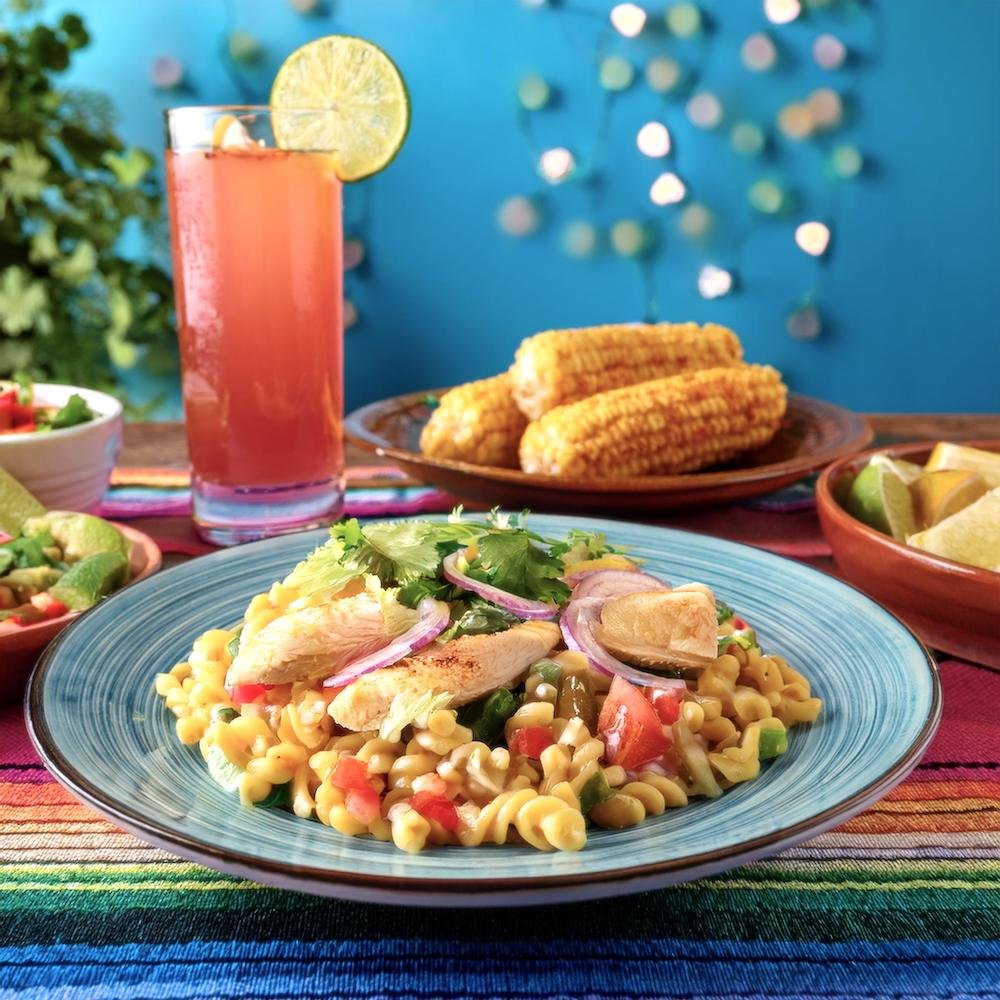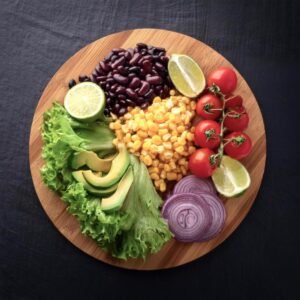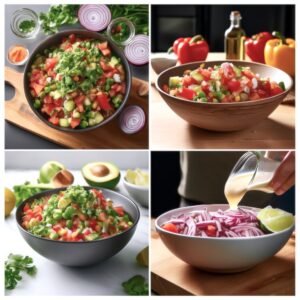What Is Mexican Salad Made Of? Mexican salad is a vibrant, colorful dish that captures the essence of Mexican cuisine in a simple, refreshing way. Featuring a combination of crisp vegetables, zesty dressings, and hearty add-ins like beans or proteins, this salad offers a perfect balance of flavors and textures. Whether served as a side dish or enjoyed as a light meal, Mexican salad is a versatile option suitable for any occasion.
Rooted in traditional Mexican flavors, this salad often includes ingredients like fresh cilantro, lime, avocados, and chili powder, making it both nutritious and delicious. In this article, we’ll break down the essential components of a Mexican salad, its variations, and how to prepare it to perfection at home.
The Core Ingredients of Mexican Salad
The beauty of a Mexican salad lies in its adaptability, but several core ingredients define its unmistakable flavor and appeal. Let’s dive into what makes up this classic dish.
Common Vegetables Used
- Romaine Lettuce or Mixed Greens
- Forms the base of most Mexican salads, providing a crisp, fresh texture.
- Can be substituted with iceberg lettuce, spinach, or kale for a unique twist.
- Tomatoes
- Diced Roma or cherry tomatoes add a juicy, tangy element to the salad.
- Fresh salsa or pico de gallo can also be incorporated for extra zest.
- Corn
- Sweet corn kernels (fresh, grilled, or canned) enhance the salad’s texture and sweetness.
- Grilled corn, in particular, adds a smoky flavor that complements other ingredients.
- Bell Peppers
- Red, yellow, or green bell peppers contribute a crunch and vibrant color.
- These can be raw or lightly sautéed for a softer texture.
- Onions
- Red onions or green onions offer a mild, tangy bite.
- Pickled onions can be used for a more sophisticated flavor profile.
- Avocado
- Creamy diced avocado or guacamole adds richness to the salad.
- Provides healthy fats and a signature Mexican touch.
Protein Options
While the salad can remain entirely plant-based, adding proteins transforms it into a hearty meal:
- Grilled Chicken
- A classic choice that pairs beautifully with the salad’s fresh and zesty elements.
- Shrimp
- Marinated and grilled shrimp adds a touch of elegance and flavor.
- Black Beans or Pinto Beans
- A staple in Mexican cuisine, beans add plant-based protein and fiber.
- Beef or Pork
- Ground beef, shredded pork, or carnitas can be included for a richer dish.
- Tofu or Tempeh
- A vegan-friendly option that absorbs the salad’s spices and dressings perfectly.
Dressings and Toppings
The dressing and toppings play a vital role in defining the salad’s Mexican identity:
- Zesty Lime Dressing
- A simple combination of lime juice, olive oil, garlic, and seasonings like cumin and chili powder.
- Creamy Avocado Dressing
- Made with blended avocado, lime juice, and Greek yogurt or sour cream.
- Toppings
- Crumbled Cotija or queso fresco cheese adds a salty, tangy finish.
- Tortilla strips or crushed chips provide crunch and texture.
- Fresh cilantro leaves give the salad its authentic Mexican aroma.
Variations of Mexican Salad
Mexican salad is incredibly versatile, with endless variations to suit different tastes, occasions, and dietary preferences. From hearty taco salads to avocado-rich bowls, these adaptations make it easy to enjoy Mexican flavors in new and exciting ways.
Taco Salad
One of the most popular variations, taco salad combines the best elements of tacos with the freshness of a salad.
- Key Features
- A bed of crispy lettuce topped with seasoned ground beef, shredded cheese, and diced tomatoes.
- Often served with tortilla chips or a crispy tortilla bowl for added texture.
- Customizations
- Swap ground beef for grilled chicken, shrimp, or black beans for a healthier or vegetarian-friendly option.
- Use salsa or sour cream as the dressing for a classic taco-inspired flavor.
- Why It Stands Out
- Taco salad is hearty enough to serve as a main course, making it a perfect choice for lunch or dinner.
Variations of Mexican Salad
Mexican salad is incredibly versatile, with endless variations to suit different tastes, occasions, and dietary preferences. From hearty taco salads to avocado-rich bowls, these adaptations make it easy to enjoy Mexican flavors in new and exciting ways.
Taco Salad
One of the most popular variations, taco salad combines the best elements of tacos with the freshness of a salad.
- Key Features
- A bed of crispy lettuce topped with seasoned ground beef, shredded cheese, and diced tomatoes.
- Often served with tortilla chips or a crispy tortilla bowl for added texture.
- Customizations
- Swap ground beef for grilled chicken, shrimp, or black beans for a healthier or vegetarian-friendly option.
- Use salsa or sour cream as the dressing for a classic taco-inspired flavor.
- Why It Stands Out
- Taco salad is hearty enough to serve as a main course, making it a perfect choice for lunch or dinner.
Avocado-Based Mexican Salads
Avocado takes center stage in these variations, offering creamy richness and bold flavor.
- Avocado Salad Bowl
- Features diced avocado, tomatoes, onions, and cilantro mixed with a lime and olive oil dressing.
- Light, refreshing, and perfect as a side dish.
- Avocado and Mango Salad
- Combines avocado with juicy mango slices, jalapeños, and red onions for a sweet and spicy twist.
- Ideal for summer gatherings or as a pairing with grilled seafood.
- Benefits
- These salads highlight the health benefits of avocado, including its heart-healthy fats and vitamins.
Protein-Rich Mexican Salads
Adding proteins like chicken, beef, or seafood can turn a simple salad into a filling, balanced meal.
- Grilled Chicken Salad
- Marinated chicken breast is sliced and placed over a mix of greens, corn, black beans, and bell peppers.
- A drizzle of chipotle lime dressing ties it all together.
- Seafood Salad
- Shrimp or fish (like tilapia) seasoned with chili powder and garlic adds a coastal flair.
- Perfectly paired with a tangy citrus dressing.
- Vegetarian Protein Options
- Black beans, pinto beans, or quinoa can replace meat for a plant-based version without sacrificing protein.
Grain-Based Mexican Salads
Incorporating grains like quinoa or rice adds an extra layer of texture and heartiness:
- Mexican Quinoa Salad
- Cooked quinoa combined with corn, black beans, and diced tomatoes creates a nutrient-dense dish.
- A cilantro-lime vinaigrette enhances its flavor.
- Fiesta Rice Salad
- This variation uses cooked white or brown rice as the base, layered with vegetables and salsa.
Spicy Mexican Salads
For those who enjoy bold flavors, spicy variations add a kick to traditional Mexican salads:
- Jalapeño Salad
- Fresh jalapeño slices mixed with greens, cucumbers, and lime dressing bring heat and crunch.
- Chipotle Salad
- Incorporates chipotle peppers in adobo sauce into the dressing for a smoky, spicy twist.
Why Variations Matter
The adaptability of Mexican salad means there’s a version for every taste and dietary need. From indulgent taco salads to light avocado-based bowls, these variations ensure there’s always something new to explore.
Avocado-Based Mexican Salads
Avocado takes center stage in these variations, offering creamy richness and bold flavor.
- Avocado Salad Bowl
- Features diced avocado, tomatoes, onions, and cilantro mixed with a lime and olive oil dressing.
- Light, refreshing, and perfect as a side dish.
- Avocado and Mango Salad
- Combines avocado with juicy mango slices, jalapeños, and red onions for a sweet and spicy twist.
- Ideal for summer gatherings or as a pairing with grilled seafood.
- Benefits
- These salads highlight the health benefits of avocado, including its heart-healthy fats and vitamins.
Protein-Rich Mexican Salads
Adding proteins like chicken, beef, or seafood can turn a simple salad into a filling, balanced meal.
- Grilled Chicken Salad
- Marinated chicken breast is sliced and placed over a mix of greens, corn, black beans, and bell peppers.
- A drizzle of chipotle lime dressing ties it all together.
- Seafood Salad
- Shrimp or fish (like tilapia) seasoned with chili powder and garlic adds a coastal flair.
- Perfectly paired with a tangy citrus dressing.
- Vegetarian Protein Options
- Black beans, pinto beans, or quinoa can replace meat for a plant-based version without sacrificing protein.
Grain-Based Mexican Salads
Incorporating grains like quinoa or rice adds an extra layer of texture and heartiness:
- Mexican Quinoa Salad
- Cooked quinoa combined with corn, black beans, and diced tomatoes creates a nutrient-dense dish.
- A cilantro-lime vinaigrette enhances its flavor.
- Fiesta Rice Salad
- This variation uses cooked white or brown rice as the base, layered with vegetables and salsa.
Spicy Mexican Salads
For those who enjoy bold flavors, spicy variations add a kick to traditional Mexican salads:
- Jalapeño Salad
- Fresh jalapeño slices mixed with greens, cucumbers, and lime dressing bring heat and crunch.
- Chipotle Salad
- Incorporates chipotle peppers in adobo sauce into the dressing for a smoky, spicy twist.
Why Variations Matter
The adaptability of Mexican salad means there’s a version for every taste and dietary need. From indulgent taco salads to light avocado-based bowls, these variations ensure there’s always something new to explore.
Nutritional Value of Mexican Salad
Mexican salad isn’t just a feast for the senses; it’s also packed with health benefits, making it a great choice for a nutritious meal. Loaded with fresh vegetables, plant-based proteins, and healthy fats, this dish delivers essential vitamins and minerals while remaining light and refreshing. Let’s dive into the nutritional highlights of Mexican salad and explore how to make it even healthier.
Health Benefits of Fresh Ingredients
1. Vegetables as the Foundation
- Ingredients like lettuce, tomatoes, bell peppers, and onions provide essential nutrients like vitamin C, vitamin A, and antioxidants.
- High in fiber, these vegetables support healthy digestion and help maintain a balanced diet.
2. Healthy Fats from Avocado
- Avocado is a star ingredient, offering monounsaturated fats that promote heart health.
- It also contains potassium, which helps regulate blood pressure, and vitamin E for healthy skin.
3. Plant-Based Proteins
- Black beans and pinto beans are rich in protein and fiber, making the salad more filling and satisfying.
- These legumes are low in fat and provide essential minerals like iron and magnesium.
Calorie and Nutrient Breakdown
A typical serving of Mexican salad (about 1.5 cups) with a light dressing provides:
| Nutrient | Approximate Value |
|---|---|
| Calories | 200–300 (depending on toppings) |
| Protein | 6–12 grams |
| Carbohydrates | 15–25 grams |
| Fat | 10–15 grams |
| Fiber | 5–8 grams |
| Sodium | 200–400 mg |
Making It Low-Calorie
1. Light Dressings
- Swap creamy dressings for a vinaigrette made with lime juice, olive oil, and a pinch of chili powder.
- Use Greek yogurt instead of sour cream for a creamy texture with fewer calories.
2. Load Up on Greens
- Increase the ratio of leafy greens to other ingredients to create a lighter, low-carb version.
3. Limit High-Calorie Add-Ons
- Use toppings like cheese or tortilla strips sparingly, focusing on fresh herbs and spices instead.
Making It Vegan or Gluten-Free
1. Vegan Adaptations
- Skip cheese and replace sour cream with a plant-based alternative.
- Add more beans or tofu for protein.
2. Gluten-Free Options
- Most Mexican salads are naturally gluten-free, but double-check any pre-made dressings or tortilla chips for hidden gluten.
Nutritional Benefits in Everyday Life
Mexican salad fits seamlessly into a variety of dietary goals:
- Weight Management: Low in calories and high in fiber, it keeps you full longer.
- Heart Health: Packed with vegetables, beans, and healthy fats, it supports cardiovascular well-being.
- Balanced Meals: Add protein like grilled chicken or quinoa to turn the salad into a complete, nourishing meal.
How to Make Mexican Salad at Home
Making Mexican salad at home is simple, quick, and rewarding. With fresh ingredients and a little creativity, you can craft a vibrant dish that’s perfect for any occasion. In this section, we’ll guide you through a step-by-step recipe, tips for selecting the freshest produce, and common mistakes to avoid.
Step-by-Step Recipe for a Basic Mexican Salad
Ingredients
For a serving of 4-6 people, gather the following:
- Vegetables:
- 4 cups romaine lettuce or mixed greens, chopped
- 1 cup cherry tomatoes, halved
- 1 cup sweet corn (fresh, grilled, or canned)
- 1 cup black beans, rinsed and drained
- 1 red bell pepper, diced
- ½ red onion, thinly sliced
- 1 avocado, diced
- Dressing:
- 2 tablespoons lime juice
- 3 tablespoons olive oil
- 1 teaspoon chili powder
- ½ teaspoon cumin
- 1 garlic clove, minced
- Salt and pepper to taste
- Optional Toppings:
- Crumbled Cotija cheese or queso fresco
- Tortilla strips or crushed tortilla chips
- Fresh cilantro for garnish
Instructions
- Prepare the Vegetables
- Wash and chop the greens and other vegetables.
- If using fresh corn, boil or grill it, then cut the kernels off the cob.
- Dice the avocado just before serving to prevent browning.
- Make the Dressing
- In a small bowl, whisk together lime juice, olive oil, chili powder, cumin, garlic, salt, and pepper.
- Taste and adjust the seasoning as needed.
- Assemble the Salad
- In a large mixing bowl, combine lettuce, tomatoes, corn, beans, bell pepper, and onion.
- Pour the dressing over the salad and toss gently to coat all ingredients evenly.
- Add Toppings and Serve
- Top with avocado, Cotija cheese, tortilla strips, and cilantro.
- Serve immediately for the freshest flavor and texture.
Tips for Choosing the Freshest Ingredients
- Lettuce and Greens
- Look for crisp, bright leaves without wilting or browning.
- Store greens in the refrigerator and use them within a few days.
- Tomatoes and Avocado
- Choose ripe but firm tomatoes and avocados to avoid mushiness.
- Avocado should yield slightly to gentle pressure but not feel overly soft.
- Corn and Beans
- Use fresh corn for the sweetest flavor, or choose low-sodium canned options.
Common Mistakes to Avoid
- Overdressing the Salad
- Start with a small amount of dressing and add more as needed to prevent sogginess.
- Not Drying Greens Properly
- Ensure greens are thoroughly dried after washing to prevent the salad from becoming watery.
- Cutting Ingredients Too Early
- Chop vegetables like avocado and onion close to serving time to preserve freshness.
- Skipping Seasoning
- A pinch of salt and pepper in the salad and dressing enhances the flavors significantly.
Serving Suggestions for Mexican Salad
Mexican salad is a versatile dish that fits seamlessly into a variety of meals and occasions. From casual family dinners to festive gatherings, this salad shines with its vibrant colors and bold flavors. Let’s explore when and how to serve it, along with pairing and presentation tips to elevate your dish.
Perfect Occasions for Serving
- Weeknight Dinners
- Quick to prepare, Mexican salad makes an excellent side dish or light main course for busy evenings.
- Potlucks and Parties
- Its fresh ingredients and zesty flavors make it a crowd-pleaser that’s easy to scale up for large groups.
- Serve it in a decorative bowl for a visual centerpiece at any event.
- Summer BBQs
- Refreshing and light, this salad complements grilled meats and smoky flavors, making it a staple for barbecues.
- Holiday Celebrations
- Add a touch of color and balance to heavy holiday meals with this vibrant dish.
Ideal Pairings with Main Courses
- Grilled Meats
- Pair Mexican salad with grilled chicken, steak, or shrimp for a balanced and satisfying meal.
- Add a drizzle of chipotle or lime dressing to tie the flavors together.
- Mexican-Inspired Dishes
- Serve alongside tacos, enchiladas, quesadillas, or tamales for a cohesive theme.
- Use the salad as a topping for loaded nachos or burrito bowls.
- Vegetarian Options
- Pair with dishes like roasted vegetables, stuffed peppers, or a side of rice and beans for a hearty vegetarian meal.
Beverage Pairings
- Classic Cocktails
- A margarita (classic lime or mango) enhances the zesty, citrusy flavors of the salad.
- Micheladas or Mexican lagers are excellent choices for a refreshing pairing.
- Non-Alcoholic Options
- Serve with agua frescas (like watermelon or hibiscus) for a light and fruity complement.
- Lemonade or iced tea with a hint of mint works perfectly for casual meals.
Presentation Tips for Special Occasions
- Layered Serving
- Present the salad in a clear glass bowl to showcase the vibrant layers of vegetables, beans, and toppings.
- Garnish the top with avocado slices, cilantro sprigs, and lime wedges for a polished look.
- Individual Portions
- Serve in small mason jars or individual bowls for portion control and an elegant touch.
- Add a tortilla chip garnish for a festive presentation.
- Themed Decorations
- Incorporate Mexican-themed table settings, such as brightly colored tablecloths and plates, to enhance the meal’s appeal.
Storing and Reheating Leftovers
- Refrigeration
- Store leftover salad in an airtight container for up to 2 days. Keep the dressing separate to avoid sogginess.
- Refreshing Before Serving
- Toss the salad with fresh lime juice or a small amount of dressing before serving leftovers.
- Avoid Freezing
- Ingredients like lettuce and avocado do not freeze well, so enjoy the salad fresh or within a short timeframe.
Frequently Asked Questions (FAQs)
What lettuce is used in Mexican food?
In Mexican cuisine, romaine lettuce is commonly used due to its crisp texture and slightly sweet flavor. Iceberg lettuce is also popular, especially in Tex-Mex dishes, for its crunchy and refreshing qualities. Both types are often used as a base for salads, in tacos, or as a garnish for dishes like tostadas and enchiladas.
What is the main ingredient of a salad?
The main ingredient of a salad typically depends on the type of salad being prepared, but most feature a leafy green base. For Mexican salads, romaine lettuce or mixed greens often serve as the foundation. Other common main components include fresh vegetables (like tomatoes, corn, and peppers), proteins (like beans or chicken), and a dressing that ties the flavors together.
What are good Mexican side dishes?
Mexican cuisine offers a variety of delicious side dishes that pair well with a salad or main course, including:
Elote: Mexican street corn coated in mayonnaise, cheese, and chili powder.
Refried Beans: Creamy and flavorful, made from pinto or black beans.
Mexican Rice: Flavored with tomatoes, garlic, and spices.
Guacamole: A classic avocado-based dip served with tortilla chips.
Pico de Gallo: A fresh salsa made with tomatoes, onions, cilantro, and lime juice.
Tortilla Soup: A rich, spicy soup topped with tortilla strips and avocado.
Who invented the Mexican salad?
There isn’t a single inventor of the Mexican salad, as it is a modern adaptation of traditional Mexican culinary elements. The dish draws inspiration from authentic Mexican ingredients and techniques, like using fresh vegetables, beans, and zesty dressings. Its evolution likely came from combining Mexican flavors with the global love for salads, making it a fusion dish that celebrates Mexico’s rich culinary heritage.
Suggested Internal Links:
- What Are the Five Mistakes to Avoid Pasta Salad?
Learn how to perfect pasta salad while exploring variations with Mexican-inspired ingredients. - What Does Ditalini Mean in Italian?
Discover how unique pasta shapes, like ditalini, can enhance your Mexican-inspired dishes. - Which Type of Potato Is Best for Potato Salad?
Compare potato salad preparation techniques with Mexican salad’s fresh approach. - What Do You Eat with Cabbage Rolls? Perfect Pairings for a Delicious Meal
Find complementary side dishes for cabbage rolls, including a vibrant Mexican salad. - How to Make a Unicorn Cake?
Add a whimsical dessert to follow your Mexican-inspired meal with this magical cake recipe.
Conclusion
Mexican salad is a vibrant and versatile dish that combines the freshness of crisp vegetables, the heartiness of beans and proteins, and the bold flavors of zesty dressings. Rooted in the culinary traditions of Mexican cuisine, this salad has become a favorite worldwide for its adaptability and health benefits.
Whether served as a side dish at a festive gathering, a light main course, or a refreshing complement to your favorite Mexican dishes, Mexican salad is a must-try recipe. With endless variations and customizable ingredients, it offers something for everyone, from vegetarians to meat lovers.
Now that you know what Mexican salad is made of, it’s time to gather fresh ingredients, try the recipe, and experiment with the endless possibilities this dish has to offer. Share it with family and friends, and enjoy the vibrant flavors of Mexico in every bite!
Discover more mouthwatering recipes on our Web Site ! Stay connected and get inspired by following us on Facebook, Instagram, Pinterest, and Twitter for the latest updates!




